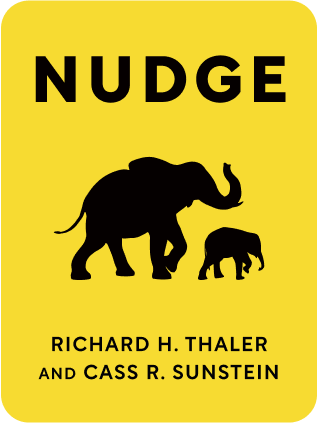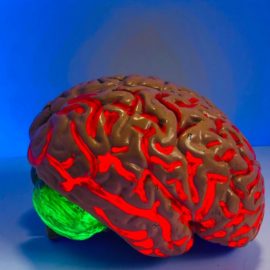

This article is an excerpt from the Shortform summary of "Nudge" by Richard H. Thaler and Cass R. Sunstein. Shortform has the world's best summaries of books you should be reading.
Like this article? Sign up for a free trial here .
What are nudges? What does it mean to nudge someone, and how do nudges work?
Nudges are methods for encouraging people to make better decisions without forcing them. The concept comes from the book Nudge by Richard Thaler and Cass Sunstein.
So, what are nudges? Read on to find out with a list of 11 examples of nudges from a variety of backgrounds.
What Are Nudges?
Of course, the reforms described in the preceding chapters just scratch the surface of what’s possible with informed choice architecture. What are nudges that go beyond what was previously described? Here are some additional examples that further illustrate what’s possible through the power of a nudge:
- Give More Tomorrow: Akin to a “Save More Tomorrow” program, “Give More Tomorrow” invites donors to charitable organizations to increase the amount of their donation annually. The increase would be calculated and charged automatically, and donors would only have to make a telephone call or visit a website to disenroll. Human inertia/status quo bias would favor the charities.
- Automatic Tax Returns: Imagine if a pre-filled tax return was sent right to your door! Already implemented in Nordic countries like Denmark and Finland, automatic tax returns are completed by the government and sent to taxpayers for approval. What are nudges improving in this situation? Economist Austan Goolsbee estimated that automatic tax returns would save Americans 225 million hours of tax preparation and over $2 billion in fees. It would make auditors’ lives easier, too.
- Stickk.com: Proposed by two Yale economists, Stickk.com facilitates people’s promises to themselves. The site would support both financial and nonfinancial commitments, and it would even support group goals among multiple committers. Say, for example, you wanted to lose 20 pounds in 2020 and were willing to risk $5,000 to force yourself to do it. If you fail to lose the weight, stickk.com would automatically send the money to charity; if you succeed, stickk.com would give the money back.
- A “Quit Smoking” Account: Piloted in the Philippines, smoking-cessation accounts can be opened with as little as one dollar and commit smokers to depositing the money they otherwise would have spent on cigarettes every week. If, at the end of six months, the depositor tests positive for nicotine, the money in the account is donated to charity; if he or she manages to get through the six months without smoking, the money is returned.
- Destiny Health Plan: Available in certain US states, the Destiny Health Plan rewards enrollees with points when they participate in certain healthful activities—for example, attending a fitness class—or meet certain health goals, say, lowering their blood pressure. These points can be traded in for plane tickets, hotel stays, and other rewards.
- Dollar-a-Day Programs: “Dollar-a-Day” programs nudge people toward more beneficial habits by paying them a small amount for every day they refrain from a harmful behavior. For example, officials in Greensboro, North Carolina, developed a program to curb teen pregnancy: They gave teenagers who had already had a baby a dollar for every day they weren’t pregnant.
- A Civility Warning: What are nudges in the age of social media? With the “hot take,” people are all too susceptible to firing off an angry tweet or text in a fit of passion. The “civility warning” would recognize the sentiment of the message you aim to send and prompt you with a question: “Warning: This appears to be an uncivil message. Do you really wish to send it?” An even stronger iteration of this nudge would force users to wait a day before sending the uncivil message.
- The “Power-Aware” Cord: Developed in Sweden in response to a government-sponsored effort to reduce energy use through design, the power-aware cord glows at different brightnesses depending on how much current is running through it (for example, it grows brighter if the light it’s attached to has been on for a long time).
- Carbon Labels: Japan and other countries are experimenting with labeling certain products with their carbon footprint in an effort to raise awareness of climate change. What are nudges in this situation? Putting information in front of people so they can make a better choice.
- Trayless Cafeterias: An experiment at Alfred University in New York found that when cafeteria patrons weren’t offered a tray, the amount of food and liquid waste produced by the cafeteria plummeted—by between 30%–50%!—because patrons couldn’t pile on food they would eventually discard. Other universities are experimenting with a similar nudge to reduce food waste.
- Procrastinator’s Clock: This watch and/or clock runs up to fifteen minutes fast, but it speeds up and slows down at random (so users can never game it).
So, what are nudges? They can take many forms with a variety of goals. But they rely on preserving free will.

———End of Preview———
Like what you just read? Read the rest of the world's best summary of Richard H. Thaler and Cass R. Sunstein's "Nudge" at Shortform .
Here's what you'll find in our full Nudge summary :
- Why subtle changes, like switching the order of two choices, can dramatically change your response
- How to increase the organ donation rate by over 50% through one simple change
- The best way for society to balance individual freedom with social welfare






